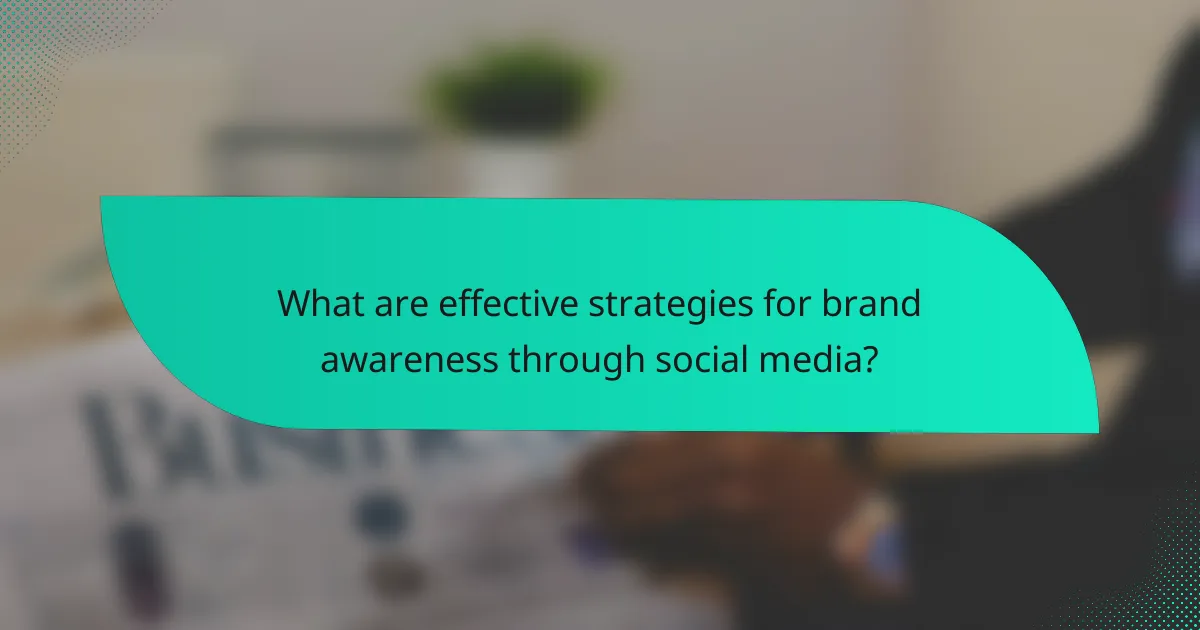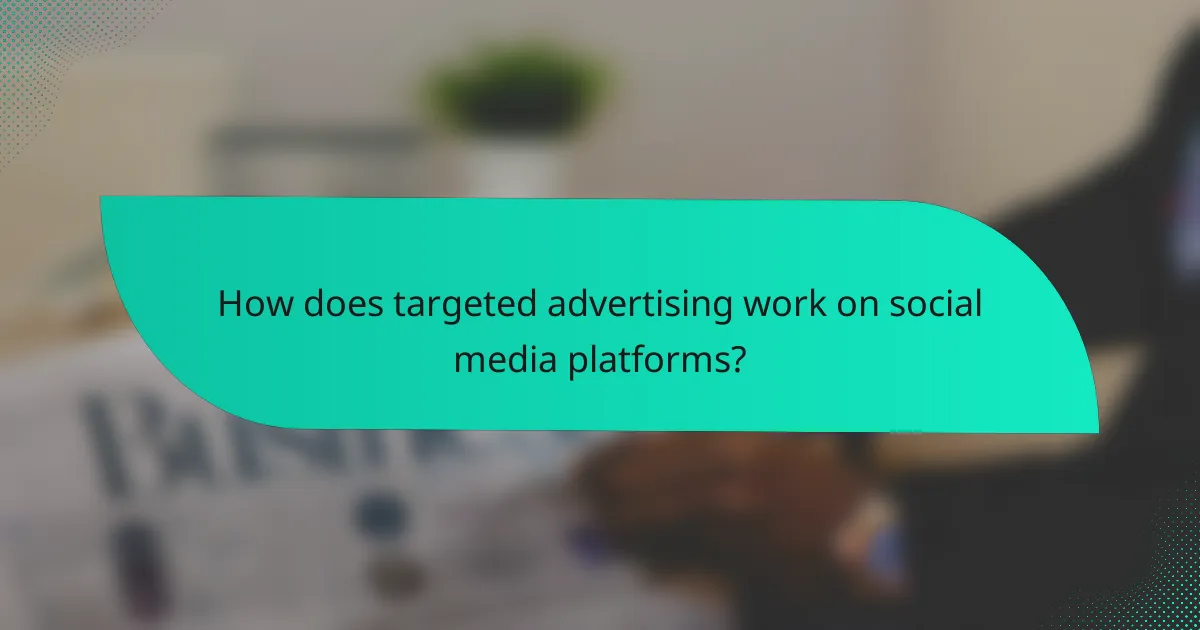Social media campaigns play a crucial role in enhancing audience engagement and brand awareness by facilitating direct interactions between brands and consumers. By employing targeted advertising and effective strategies such as influencer partnerships and visual storytelling, brands can connect meaningfully with their audience, fostering loyalty and increasing visibility.

How can social media campaigns enhance audience engagement in the UK?
Social media campaigns can significantly boost audience engagement in the UK by fostering direct interactions between brands and consumers. By leveraging various strategies, brands can create meaningful connections that enhance loyalty and visibility.
Interactive content strategies
Interactive content, such as polls, quizzes, and live videos, encourages users to participate actively rather than passively consume information. This type of content can increase engagement rates by appealing to the audience’s desire for involvement and feedback.
Brands should consider incorporating interactive elements into their posts, such as Instagram Stories polls or Facebook Live Q&A sessions. These strategies can lead to higher interaction rates, often exceeding traditional content engagement by significant margins.
Utilizing user-generated content
User-generated content (UGC) involves sharing content created by customers, which can enhance authenticity and trust. By encouraging customers to share their experiences with products or services, brands can build a community around their offerings.
In the UK, brands can incentivize UGC through contests or hashtags, prompting users to share their content in exchange for recognition or rewards. This approach not only increases engagement but also provides fresh content that resonates with potential customers.
Real-time engagement tactics
Real-time engagement tactics, such as responding promptly to comments and messages, are crucial for maintaining audience interest. Quick responses can enhance customer satisfaction and foster a sense of community around the brand.
Brands should monitor their social media channels actively, aiming to respond to inquiries within a few hours. Utilizing chatbots for immediate responses can also help manage high volumes of interactions, ensuring that no customer feels neglected.

What are effective strategies for brand awareness through social media?
Effective strategies for brand awareness on social media include leveraging influencer partnerships, utilizing content marketing techniques, and employing visual storytelling approaches. These methods help brands connect with their target audience, enhance visibility, and foster engagement.
Influencer partnerships
Influencer partnerships involve collaborating with individuals who have a significant following on social media platforms. This strategy can amplify brand messages and reach niche audiences effectively. Brands should select influencers whose values align with their own to ensure authenticity.
When engaging with influencers, consider the type of content they produce and their audience demographics. Micro-influencers, for example, often have higher engagement rates and can be more cost-effective than larger influencers. Establish clear goals and metrics to evaluate the success of these partnerships.
Content marketing techniques
Content marketing techniques focus on creating valuable and relevant content to attract and engage a target audience. This can include blog posts, videos, infographics, and social media posts that resonate with users. Consistency in posting and maintaining a brand voice is crucial for building awareness.
Utilize analytics tools to track engagement and adjust your content strategy accordingly. Experiment with different formats and topics to see what resonates best with your audience. Incorporating user-generated content can also enhance authenticity and encourage community involvement.
Visual storytelling approaches
Visual storytelling approaches leverage images, videos, and graphics to convey a brand’s message and values. This method captures attention quickly and can evoke emotions, making it a powerful tool for brand awareness. High-quality visuals should align with the brand’s identity and appeal to the target audience.
Consider using platforms like Instagram and TikTok, which prioritize visual content. Short, engaging videos or eye-catching images can significantly increase shareability. Always include a clear call to action to guide viewers on what to do next, whether it’s visiting a website or sharing the content.

How does targeted advertising work on social media platforms?
Targeted advertising on social media platforms involves using user data to deliver personalized ads to specific audience segments. This approach enhances engagement and improves the likelihood of conversions by ensuring that the right message reaches the right people at the right time.
Demographic targeting on Facebook
Demographic targeting on Facebook allows advertisers to reach users based on characteristics such as age, gender, location, and education level. For instance, a local coffee shop can target users aged 18-35 within a specific city to promote a new product launch.
Advertisers can refine their audience further by selecting interests and behaviors that align with their brand. This ensures that ads resonate with potential customers, increasing the chances of engagement and sales.
Behavioral targeting on Instagram
Behavioral targeting on Instagram focuses on users’ online activities, such as their interactions with posts, stories, and advertisements. By analyzing user behavior, brands can create tailored ads that reflect users’ interests and preferences.
For example, a fitness brand might target users who frequently engage with fitness-related content, showcasing products that align with their lifestyle. This method enhances the relevance of ads, leading to higher engagement rates.
Retargeting strategies on LinkedIn
Retargeting on LinkedIn involves showing ads to users who have previously interacted with a brand’s content or website. This strategy is effective for B2B companies aiming to re-engage potential clients who may not have converted initially.
For instance, a software company can retarget users who visited their product page but did not sign up for a demo. By reminding these users of the benefits, the company increases the likelihood of conversion. It’s crucial to craft compelling ad copy that addresses the user’s previous interactions to maximize effectiveness.

What are the key metrics for measuring social media campaign success?
The key metrics for measuring social media campaign success include engagement rate, conversion rate, reach, and impressions. These metrics help businesses understand how well their campaigns resonate with the audience and drive desired actions.
Engagement rate analysis
Engagement rate is a critical metric that reflects how actively users interact with your content. It is calculated by dividing the total engagements (likes, shares, comments) by the total reach or impressions, often expressed as a percentage. A higher engagement rate indicates that your audience finds the content relevant and appealing.
To improve engagement rates, focus on creating high-quality, shareable content that encourages interaction. Consider using polls, questions, or visually appealing graphics to spark conversations. Aim for engagement rates typically ranging from 1% to 5%, depending on the platform and industry.
Conversion tracking methods
Conversion tracking measures how many users complete a desired action after engaging with your campaign, such as making a purchase or signing up for a newsletter. This can be done using tools like Google Analytics, Facebook Pixel, or other tracking software that monitors user behavior across platforms.
To effectively track conversions, set clear goals for each campaign and implement tracking codes or pixels on your website. Regularly analyze the data to identify which campaigns yield the highest conversion rates and adjust your strategies accordingly. Aiming for conversion rates between 2% and 10% is a common benchmark, but this can vary by industry and campaign type.

What prerequisites should be considered before launching a social media campaign?
Before launching a social media campaign, it’s essential to establish a clear understanding of your target audience and set specific campaign objectives. These prerequisites will guide your strategy and help ensure effective engagement and brand awareness.
Defining target audience
Identifying your target audience is crucial for tailoring your messaging and content. Consider demographics such as age, gender, location, and interests to create a detailed profile of your ideal customer.
Utilize tools like social media analytics and surveys to gather insights about your audience’s preferences and behaviors. This data will help you craft content that resonates and drives engagement.
Setting campaign objectives
Establishing clear objectives for your social media campaign is vital for measuring success. Common goals include increasing brand awareness, driving website traffic, or boosting sales.
Use the SMART criteria—Specific, Measurable, Achievable, Relevant, Time-bound—to define your objectives. For example, aim to increase your follower count by a specific percentage within a set timeframe to track progress effectively.

What tools can optimize social media campaigns in the UK?
To optimize social media campaigns in the UK, businesses can utilize a variety of tools that enhance audience engagement, brand awareness, and targeted advertising. These tools help streamline content creation, analyze performance metrics, and improve overall campaign effectiveness.
Social Media Management Tools
Social media management tools like Hootsuite and Buffer allow businesses to schedule posts, monitor engagement, and analyze audience interactions across multiple platforms. These tools can save time and ensure consistent messaging, which is crucial for maintaining brand awareness.
When selecting a management tool, consider features such as analytics, user interface, and integration capabilities with other marketing software. Many tools offer free trials, enabling businesses to test their functionality before committing to a subscription.
Analytics Platforms
Analytics platforms such as Google Analytics and Sprout Social provide insights into campaign performance, audience demographics, and engagement rates. Understanding these metrics is vital for refining strategies and maximizing the impact of social media efforts.
Regularly reviewing analytics can help identify which content resonates most with your audience, allowing for data-driven adjustments. Aim to track key performance indicators (KPIs) like click-through rates and conversion rates to gauge success.
Content Creation Tools
Tools like Canva and Adobe Spark facilitate the creation of visually appealing content tailored for social media. High-quality visuals can significantly enhance engagement and help convey brand messages effectively.
Utilize templates and design elements that align with your brand identity to maintain consistency. Experiment with different formats, such as infographics or short videos, to see what captures your audience’s attention best.
Targeted Advertising Solutions
Platforms like Facebook Ads and LinkedIn Ads offer targeted advertising solutions that allow businesses to reach specific demographics based on interests, behaviors, and location. This precision can lead to higher conversion rates and better ROI.
When setting up ads, define your target audience clearly and test different ad formats and messaging. Monitor performance closely and adjust your strategy based on what yields the best results.
